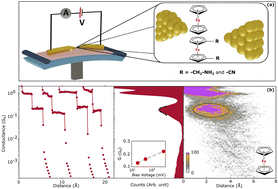Resonant transport in a highly conducting single molecular junction via metal–metal covalent bond†
Abstract
Achieving highly transmitting molecular junctions through resonant transport at low bias is key to the next-generation low-power molecular devices. Although resonant transport in molecular junctions was observed by connecting a molecule between the metal electrodes via chemical anchors by applying a high source–drain bias (>1 V), the conductance was limited to <0.1G0, G0 being the quantum of conductance. Herein, we report electronic transport measurements by directly connecting a ferrocene molecule between Au electrodes under ambient conditions in a mechanically controllable break junction setup (MCBJ), revealing a conductance peak at ∼0.2G0 in the conductance histogram. A similar experiment was repeated for ferrocene terminated with amine (–NH2) and cyano (–CN) anchors, where conductance histograms exhibit an extended low conductance feature, including the sharp high conductance peak, similar to pristine ferrocene. The statistical analysis of the data and density functional theory-based transport calculation suggest a possible molecular conformation with a strong hybridization between the Au electrodes, and that the Fe atom of ferrocene is responsible for a near-perfect transmission in the vicinity of the Fermi energy, leading to the resonant transport at a small applied bias (<0.5 V). Moreover, calculations including van der Waals/dispersion corrections reveal a covalent-like organometallic bonding between Au and the central Fe atom of ferrocene, having bond energies of ∼660 meV. Overall, our study not only demonstrates the realization of an air-stable highly transmitting molecular junction, but also provides important insights about the nature of chemical bonding at the metal/organo-metallic interface.



 Please wait while we load your content...
Please wait while we load your content...